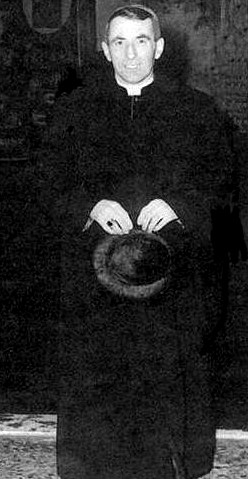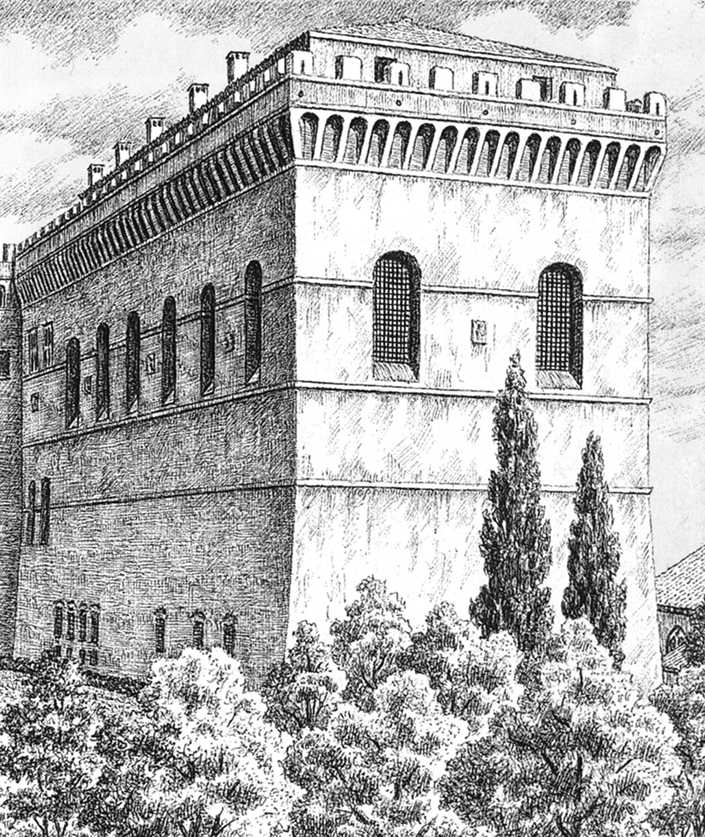|
Marcantonio Bragadin (cardinal)
Marcantonio Bragadin (1591 – 28 March 1658) was a Venetian Catholic cardinal who served as Bishop of Vicenza. Life Marcantonio Bragadin was born in Venice in 1591 (other sources indicate 1590 or 1594). His grandfather was Marco Antonio Bragadin, famous for having been flayed alive after the Ottoman conquest of Famagusta in 1571. His father, Antonio, had been one of the leaders of the Council of Ten in 1607. Marcantonio completed his studies earning a doctorate in utroque iure. He initially took the political career in the Republic of Venice, but already in 1624 moved to Rome and became an ecclesiastic: on 28 September 1626 he was ordained priest. He took up a career in the administration of the Papal States: on 17 March 1627 he became referendary of the Tribunals of the Apostolic Signature, in April to December 1627 he was governor of Fabriano, then in 1628 governor of Sabina and later of Narni. On 3 December 1630 Bragadin was appointed Bishop of Crema, which was a Ve ... [...More Info...] [...Related Items...] OR: [Wikipedia] [Google] [Baidu] |
Cardinal Priest
A cardinal ( la, Sanctae Romanae Ecclesiae cardinalis, literally 'cardinal of the Holy Roman Church') is a senior member of the clergy of the Catholic Church. Cardinals are created by the ruling pope and typically hold the title for life. Collectively, they constitute the College of Cardinals. Their most solemn responsibility is to elect a new pope in a conclave, almost always from among themselves (with a few historical exceptions), when the Holy See is vacant. During the period between a pope's death or resignation and the election of his successor, the day-to-day governance of the Holy See is in the hands of the College of Cardinals. The right to participate in a conclave is limited to cardinals who have not reached the age of 80 years by the day the vacancy occurs. In addition, cardinals collectively participate in papal consistories (which generally take place annually), in which matters of importance to the Church are considered and new cardinals may be created. Cardina ... [...More Info...] [...Related Items...] OR: [Wikipedia] [Google] [Baidu] |
Diocese Of Ceneda
The Diocese of Vittorio Veneto ( la, Dioecesis Victoriensis Venetorum) is a Roman Catholic diocese in northern Italy, with capital in Vittorio Veneto. It was historically known as Diocese of Ceneda, the name being changed in 1939."Diocese of Vittorio Veneto" ''''. David M. Cheney. Retrieved February 29, 2016"Diocese of Vittorio Veneto" ''GCatholic.org''. Gabriel Chow. Retrieved February 29, 2016 Ceneda began as a |
Sistine Chapel
The Sistine Chapel (; la, Sacellum Sixtinum; it, Cappella Sistina ) is a chapel in the Apostolic Palace, the official residence of the pope in Vatican City. Originally known as the ''Cappella Magna'' ('Great Chapel'), the chapel takes its name from Pope Sixtus IV, who had it built between 1473 and 1481. Since that time, the chapel has served as a place of both religious and functionary papal activity. Today, it is the site of the papal conclave, the process by which a new pope is selected. The fame of the Sistine Chapel lies mainly in the frescoes that decorate the interior, most particularly the Sistine Chapel ceiling and ''The Last Judgment'', both by Michelangelo. During the reign of Sixtus IV, a team of Renaissance painters that included Sandro Botticelli, Pietro Perugino, Pinturicchio, Domenico Ghirlandaio and Cosimo Rosselli, created a series of frescos depicting the ''Life of Moses'' and the ''Life of Christ'', offset by papal portraits above and '' trompe-l' ... [...More Info...] [...Related Items...] OR: [Wikipedia] [Google] [Baidu] |
Episcopal Consecration
A bishop is an ordained clergy member who is entrusted with a position of authority and oversight in a religious institution. In Christianity, bishops are normally responsible for the governance of dioceses. The role or office of bishop is called episcopacy. Organizationally, several Christian denominations utilize ecclesiastical structures that call for the position of bishops, while other denominations have dispensed with this office, seeing it as a symbol of power. Bishops have also exercised political authority. Traditionally, bishops claim apostolic succession, a direct historical lineage dating back to the original Twelve Apostles or Saint Paul. The bishops are by doctrine understood as those who possess the full priesthood given by Jesus Christ, and therefore may ordain other clergy, including other bishops. A person ordained as a deacon, priest (i.e. presbyter), and then bishop is understood to hold the fullness of the ministerial priesthood, given responsibility b ... [...More Info...] [...Related Items...] OR: [Wikipedia] [Google] [Baidu] |
Narni
Narni (in Latin, Narnia) is an ancient hilltown and ''comune'' of Umbria, in central Italy, with 19,252 inhabitants (2017). At an altitude of 240 m (787 ft), it overhangs a narrow gorge of the Nera River in the province of Terni. It is very close to the geographic center of Italy.Narni – Journey to the Center of Italy Goeurope.about.com. Retrieved on 2017-10-29. There is a stone on the exact spot with a sign in multiple languages. Goeurope.about.com. Retrieved on 2017-10-29. History The area around Narni was already inhabited in the |
Sabina (region)
Sabina (Latin: ''Sabinum''), also called the Sabine Hills, is a region in central Italy. It is named after Sabina, the territory of the ancient Sabines, which was once bordered by Latium to the south, Picenum to the east, ancient Umbria to the north and Etruria to the west. It was separated from Umbria by the River Nar, today's Nera, and from Etruria by the River Tiber. Today, Sabina is mainly northeast of Rome in the regions Lazio, Umbria and Abruzzo. ''Upper Sabina'' is in the province of Rieti ( Poggio Mirteto, Magliano Sabina, Casperia, Montopoli di Sabina, Torri in Sabina, Cantalupo in Sabina, Montebuono, Forano, Poggio Catino, Montasola, Stimigliano, Castelnuovo di Farfa, Fara in Sabina, Roccantica, Mompeo, Salisano, Cottanello, Configni, Vacone, Tarano, Collevecchio, Toffia, Poggio Nativo, Scandriglia ecc.). ''Sabina Romana'' is in the province of Rome (Mentana, Monteflavio, Montelibretti, Monterotondo, Montorio Romano, Moricone, Nerola, Palombara Sabina). Pa ... [...More Info...] [...Related Items...] OR: [Wikipedia] [Google] [Baidu] |
Fabriano
Fabriano is a town and ''comune'' of Ancona province in the Italian region of the Marche, at above sea level. It lies in the Esino valley upstream and southwest of Jesi; and east-northeast of Fossato di Vico and east of Gubbio (both in Umbria). Its location on the main highway and rail line from Umbria to the Adriatic make it a mid-sized regional center in the Apennines. Fabriano is the headquarters of the giant appliance maker Indesit (partly owned by Whirlpool). Fabriano, with Roma, Parma, Torino and Carrara, is an Italian creative city (UNESCO). The town is in the category ''Folk Arts'' (for the Fabriano's handmade paper production). History Fabriano appears to have been founded in the early Middle Ages by the inhabitants of a small Roman town south at Attiggio (Latin ''Attidium''), of which some slight remains and inscriptions are extant. Fabriano itself was one of the earliest places in Europe to make high-quality paper on an industrial scale, starting in the 13th centu ... [...More Info...] [...Related Items...] OR: [Wikipedia] [Google] [Baidu] |
Apostolic Signature
The Supreme Tribunal of the Apostolic Signatura () is the highest judicial authority in the Catholic Church (apart from the pope himself, who as supreme ecclesiastical judge is the final point of appeal for any ecclesiastical judgment). In addition, it oversees the administration of justice in the church.Apostolic constitution ''Pastor Bonus'', 121-125 (translation revised by the ). Since 8 November 2014, the prefect of the Supreme Tribunal of the Apostolic Signatura has been Cardinal [...More Info...] [...Related Items...] OR: [Wikipedia] [Google] [Baidu] |
Referendary
Referendary is the English form of a number of administrative positions, of various rank, in chanceries and other official organizations in Europe. Pre-modern history The office of ' (plural: ', from the Latin ', "I inform") existed at the Byzantine Court. Such officials reported to the Emperor on the memorials of petitioners, and conveyed to the judges the Emperor's orders in connection with such memorials. During the Frankish Empire's Merovingian period, the official who would later be known as the chancellor (') was termed the '. See also Royal Administration of Merovingian and Carolingian Dynasties. Other medieval kingdoms also had a referendary, e.g., Anianus, who in 506 CE compiled the '' Breviary of Alaric'' for that king of the Visigoths. Later the office proliferated and thus became devalued, as reflected in compound titles differentiating some such offices, e.g., in the Polish-Lithuanian Commonwealth. In later iterations of the Polish state, the title occurred ag ... [...More Info...] [...Related Items...] OR: [Wikipedia] [Google] [Baidu] |
Papal States
The Papal States ( ; it, Stato Pontificio, ), officially the State of the Church ( it, Stato della Chiesa, ; la, Status Ecclesiasticus;), were a series of territories in the Italian Peninsula under the direct Sovereignty, sovereign rule of the pope from 756 until 1870. They were among the major List of historic states of Italy, states of Italy from the 8th century until the unification of Italy, between 1859 and 1870. The state had its origins in the rise of Christianity throughout Italy, and with it the rising influence of the Christian Church. By the mid-8th century, with the decline of the Byzantine Empire in Italy, the Papacy became effectively sovereign. Several Christian rulers, including the Frankish kings Charlemagne and Pepin the Short, further donated lands to be governed by the Church. During the Renaissance, the papal territory expanded greatly and the pope became one of Italy's most important secular rulers as well as the head of the Church. At their zenith, the ... [...More Info...] [...Related Items...] OR: [Wikipedia] [Google] [Baidu] |
Priesthood (Catholic Church)
The priesthood is the office of the ministers of religion, who have been commissioned (" ordained") with the Holy orders of the Catholic Church. Technically, bishops are a priestly order as well; however, in layman's terms ''priest'' refers only to presbyters and pastors (parish priests). The church's doctrine also sometimes refers to all baptised ( lay) members as the "common priesthood", which can be confused with the ministerial priesthood of the consecrated clergy. The church has different rules for priests in the Latin Church–the largest Catholic particular church–and in the 23 Eastern Catholic Churches. Notably, priests in the Latin Church must take a vow of celibacy, whereas most Eastern Catholic Churches permit married men to be ordained. Deacons are male and usually belong to the diocesan clergy, but, unlike almost all Latin Church (Western Catholic) priests and all bishops from Eastern or Western Catholicism, they may marry as laymen before their ordination ... [...More Info...] [...Related Items...] OR: [Wikipedia] [Google] [Baidu] |





.png)
